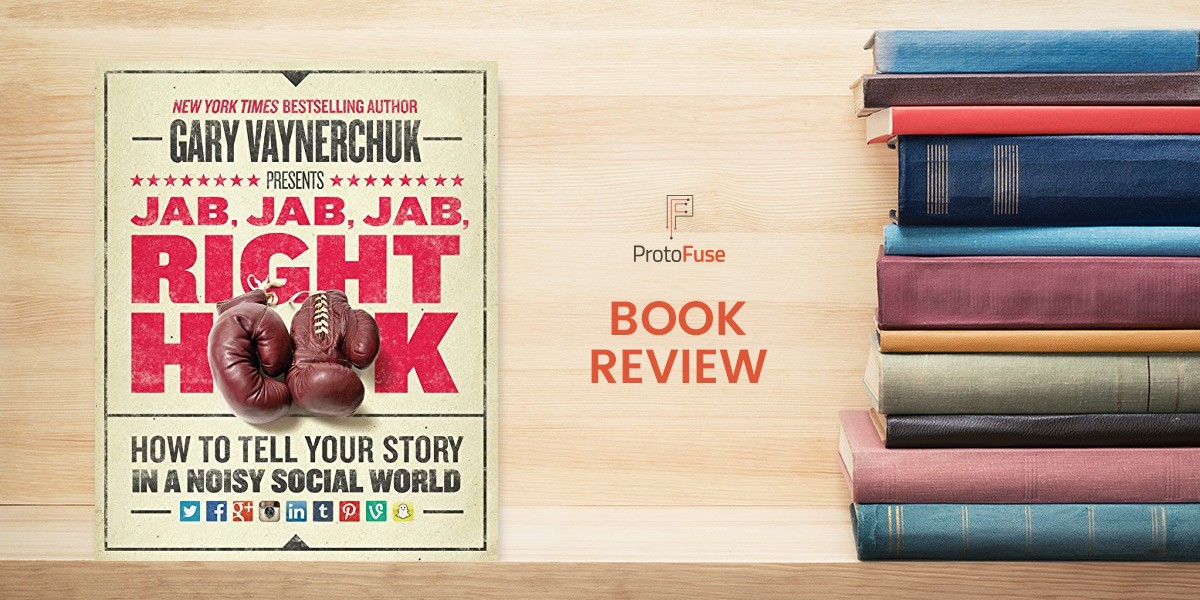
Book Review: “Jab, Jab, Jab, Right Hook” by Gary V.
Updated last on:
April 4, 2023
Gary Vaynerchuk’s no-nonsense writing style in “Jab, Jab, Jab, Right Hook: How to Tell Your Story in a Noisy Social World” is exactly what the world of social marketing needed.

by Eric Sharp
TOPICS:
Who’s this book for?
If social media feels like a foreign language you wish you knew, or you’re looking for a blueprint to improving your existing social media marketing, buy this book today.
Gary Vaynerchuk’s no-nonsense writing style in Jab, Jab, Jab, Right Hook: How to Tell Your Story in a Noisy Social World is exactly what the world of social marketing needed.
The book boasts over 80 detailed case studies from Facebook, Twitter, Instagram & Pinterest. I loved the fresh approach of mixing strategy and execution tips — a rare combination that many marketing books don’t mingle.
Here’s the concept of his title, “Jab, Jab, Jab, Right Hook”:
Jabs are the lightweight pieces of content that benefit your customers by making them laugh, snicker, ponder, play a game, feel appreciated, or escape; right hooks are calls to action that benefit your businesses.
In other words, “Jab, jab, jab, jab, jab . . . right hook! Or . . . Give, give, give, give, give . . . ask.”
Here are my 4 biggest takeaways.
1. Each platform is unique and requires a unique formula — what works on Facebook won’t necessarily work on Twitter
We’ve all gotten this wrong at one point during our social media journey, right? Blasting a single message across multiple social platforms is not social media marketing — that’s just lazy.
Every social platform needs to have its own strategy and execution style. What works for the goose certainly does not work for the gander in this case.
- Every social platform has its own nuances
- Every social platform has its own language
- Every social platform allows you to highlight different aspects of your brand identity
2. Social continues to grow rapidly in ways that impact all types of businesses in all industries
“It took thirty-eight years before 50 million people gained access to radios. It took television thirteen years to earn an audience that size. It took Instagram a year and a half.”
Instagram established an audience of 50 million 6x faster than television. Think that audience is comprised of mostly teenagers and hipsters? Think again.
Boomers, who control 70 percent of U.S. spending, increased their social usage 42 percent in one year.
Many SMBs still don’t believe in social media, and most don’t understand it. In spite of the ignorance, audiences continue to flock towards social channels at supersonic speed. The companies that believe in it and understand its power will gain a sharp edge in their industry.
3. Facebook defines quality content differently than most people think
Just like Google has their own unique (and super smart) algorithm, so does Facebook. It’s called “EdgeRank”.
Through EdgeRank, Facebook weighs likes, comments, and shares, but it currently does not give greater weight to click-throughs or any other action that leads to sales. EdgeRank doesn’t care, actually, whether you sell anything, ever.
- Facebook cares about telling a great story and “EdgeRank” is how they carry out that mission
- Posts with many likes/shares is a huge indicator of engagement, which then impacts future posts and the likelihood it’ll be seen in people’s News Feed (remember this when posting your next call to action)
- Most consumers will not go directly to your fan page for your Facebook content, mainly because half of users (250 million) are using their mobile device to consume content through their news feed (a compelling reason to post content that strives for engagement)
4. Twitter is less about the content it produces, and more about CONTEXT
Twitter has always been the social network that’s monopolized my attention. Maybe it’s their open-door policy (tweets are public) or that it forces users to practice brevity and clarity (140 character limit).
Or, maybe it’s “… the only platform where you can jump into a conversation unannounced and no one thinks you’re a stalker” as Gary puts it.
- Twitter is about listening well by adding context to ongoing shared content (which could be your own) and discussions
- The main mistake people make is thinking Twitter is simply a primary extension of their blog (I see this way too often)
- “Birdiebrag” = when you retweet favorable things people say about you (now a word in my Twitter vocabulary!) By the way, this is not necessarily frowned upon when done in moderation
It was also satisfying to see Gary be honest with a brand that played the “I follow you, now follow me back” game in one of the 80 case studies in the book. I agree with Gary that it’s a cheap tactic.
Any time a brand of this size is following more people than follow it back, it speaks to just how severely they are misusing their Twitter account. It’s a sign that they’re gaming the system — following people in hopes that they will follow back. It’s a cheap tactic.
“Give, Give, Give…Ask!”
I believe this one sentence summarizes the theme of Gary’s book.
Consistently create and share well manicured content that entertains/excites/educates (Jabs) so when you’re ready to post something promotional (Right Hook), your audience actually doesn’t mind the sales pitch and is more likely to engage with it.
Thank you Gary for writing in clear language and detailing so many case studies! I’ve started recommending to a handful of clients and I finally feel like I understand the blueprint to social media marketing.
Need website help?

We're all about websites — especially websites that are loved by people and Google.
Since 2001, we've been helping clients nationwide turnaround their outdated and under-performing websites.

"Our website is generating quality leads every week thanks to their website consulting."
Steve L.
Cactus Technologies
Hey, you made it!
There is gobs of information available today — I'm honored you found this article interesting enough to make it here. I hope this insight leads you to a better-performing website!


About the Author
Eric Sharp is the founder of ProtoFuse and has been in the website trenches since 1999 — right before the dot-com boom redefined the website landscape. Since then, he's accumulated 25 years of digital marketing experience and prides himself on creating websites "Loved by people and Google". Outside of websites, it's all about fam time with his wife and 3 kids. He enjoys CrossFit, cooking steak on his cast iron skillet, collecting Jordan sports cards, and Daaa Bears.







